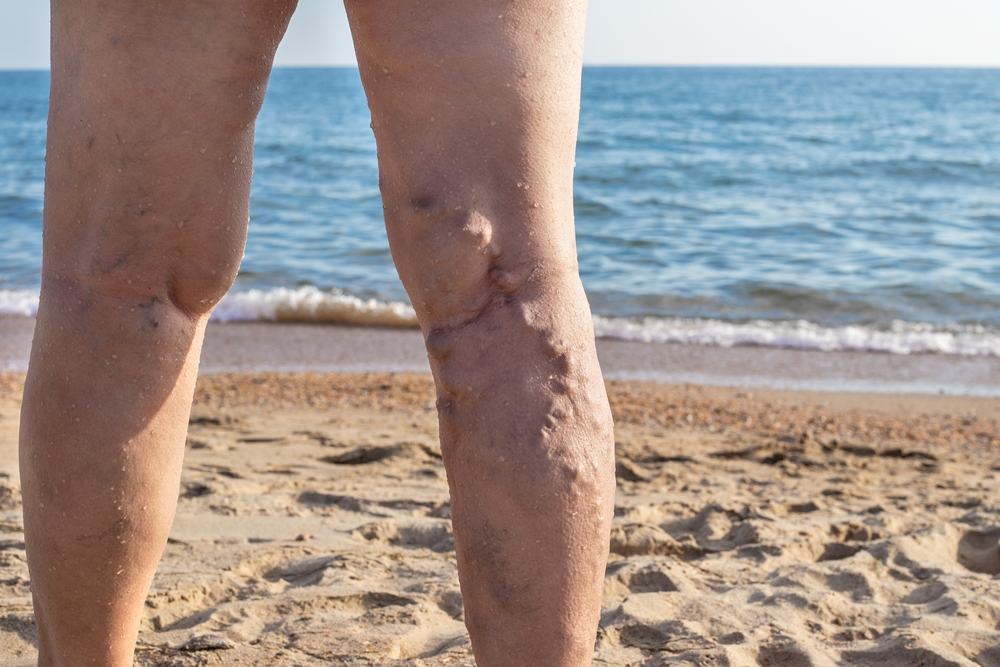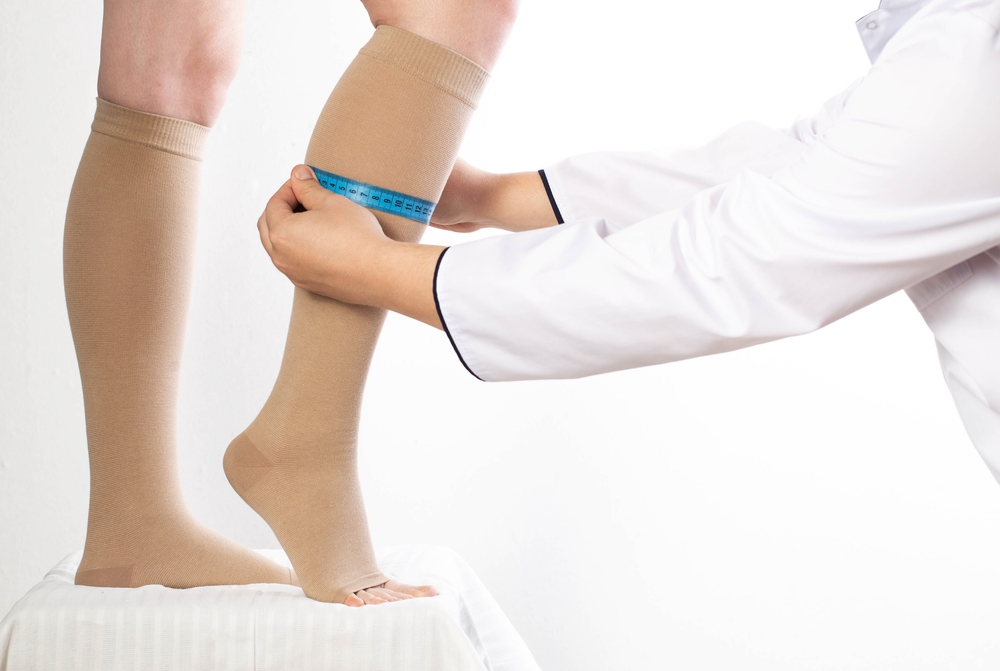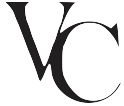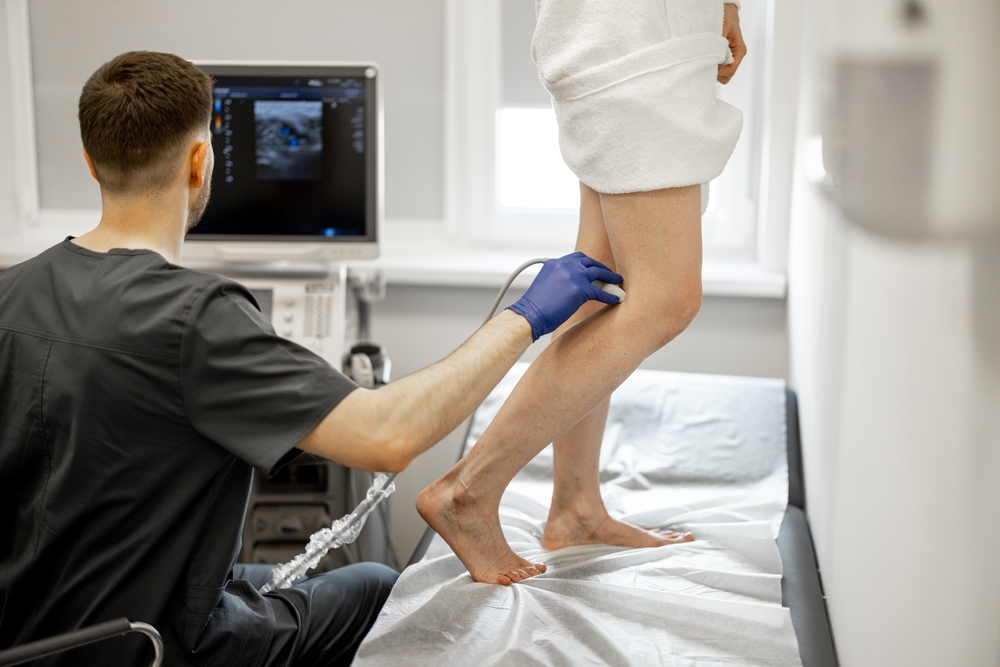Varicose veins are enlarged, twisted veins that usually appear on the legs. They can cause pain and lead to serious health issues if not treated. This article covers statistics, symptoms, causes, diagnosis, and treatment options for varicose vein conditions.
In Brief
- Varicose veins affect up to 30% of the population, with higher prevalence in women and increasing incidence with age, highlighting the need for awareness and proactive management.
- Common symptoms include twisted, bulging veins, discomfort, and itching, which can significantly impact daily activities, necessitating early recognition and treatment.
- Preventive measures and various treatment options, including lifestyle changes, compression therapy, and surgical interventions, are essential to manage varicose veins and prevent complications.
Key Statistics of Varicose Veins
Prevalence and Affected Areas
Varicose veins primarily affect the great and small saphenous veins and their tributaries, which are located between the fascia and skin. This condition is surprisingly common, with up to 30% of the general population affected, particularly among older individuals. The incidence of varicose veins within a two-year period ranges from 39.4 to 51.9 cases per 1000 individuals. Interestingly, varicose veins are more prevalent in women compared to men, highlighting the influence of gender on this condition.
Incidence in the United States
In the United States alone, it is estimated that over 40 million people suffer from varicose veins. Among those aged 50 and above, around 50% of women and 40% of men are affected. Additionally, the likelihood of developing varicose veins increases with each decade of life, with a significant spike in incidence seen in individuals over the age of 70.
Global Prevalence
Globally, the prevalence of varicose veins varies, with some studies indicating that up to 50% of women and 30% of men may experience this condition at some point in their lives. In Europe, for instance, the prevalence ranges from 20% to 40% in women and 10% to 20% in men. In Australia, approximately 25% of adults are affected by varicose veins. Moreover, a study conducted in India found that nearly 30% of the population over the age of 40 had varicose veins, underscoring its widespread impact across different regions and demographics.
Importance of Awareness and Management
These statistics underscore the widespread nature of varicose veins, emphasizing the importance of awareness and proactive management. Understanding these figures is the first step in recognizing the significance of this condition and the need for appropriate treatment and prevention strategies.
More Stats at a Glance
- Varicose veins affect up to 30% of the general population.
- Women are more likely to develop varicose veins than men.
- The incidence ranges from 39.4 to 51.9 cases per 1000 individuals over a two-year period.
- In the United States, over 40 million people suffer from varicose veins.
- Among those aged 50 and above, around 50% of women and 40% of men are affected.
- The likelihood of developing varicose veins increases with age, particularly after the age of 70.
- Globally, up to 50% of women and 30% of men may experience varicose veins at some point in their lives.
- In Europe, the prevalence ranges from 20% to 40% in women and 10% to 20% in men.
- Approximately 25% of adults in Australia are affected by varicose veins.
- A study in India found that nearly 30% of the population over the age of 40 had varicose veins.
What Do These Statistics Mean for You?
Understanding these statistics is crucial if you are at risk or may have varicose veins. The high prevalence rates indicate that varicose veins are a common condition, especially among women and older adults. This means that if you fall into these categories, you should be particularly vigilant about monitoring your vein health.
The statistics also highlight the importance of early recognition and treatment. With up to 30% of the population affected and a significant number of cases in individuals over the age of 50, taking preventive measures and seeking early intervention can help manage symptoms and prevent complications.
If you experience symptoms like bulging veins, discomfort, or itching, it is essential to consult a healthcare professional for a proper diagnosis and treatment plan. Knowing these statistics can empower you to take proactive steps in managing your condition, such as adopting lifestyle changes, using compression therapy, or considering medical procedures if necessary.
By staying informed and proactive, you can reduce the impact of varicose veins on your daily life and overall health.

Symptoms of Varicose Veins
Varicose veins are often described as twisted and bulging, resembling cords running along the legs. They can cause a heavy or achy sensation, which tends to worsen after prolonged periods of sitting or standing. This discomfort is not only a physical burden but can also impact your daily activities and quality of life, especially when accompanied by swollen veins.
In addition to the visible and physical discomfort, itching around the affected veins is a common symptom. This can lead to further irritation and discomfort, making it crucial to seek appropriate treatment. Recognizing these symptoms early on can help in diagnosing and managing varicose veins effectively.
Causes and Risk Factors for Varicose Veins
Varicose veins occur from weak or damaged valves that disrupt blood flow back to the heart, causing blood to pool and veins to enlarge. Several risk factors can increase the likelihood of developing varicose veins. A family history of varicose veins significantly raises your risk, as does obesity, which adds extra pressure on the leg veins.
Hormonal changes during menstruation, pregnancy, or menopause can also relax vein walls, increasing the risk of varicose veins. Additionally, prolonged periods of standing or sitting can hinder blood circulation, making it more likely for varicose veins to develop. Understanding these causes and risk factors can help you take preventive measures to reduce your risk.
Diagnosis of Varicose Veins
Diagnosing varicose veins typically involves a physical examination where healthcare professionals evaluate your symptoms, family history, lifestyle, and activities. This thorough assessment helps in understanding the extent and impact of the condition, especially when varicose veins diagnosed are considered.
To get a clearer picture of the affected veins and valves, an ultrasound is commonly used. This imaging test helps visualize any blood clots or inflammation in deeper veins, providing essential information for an accurate diagnosis. Duplex ultrasound, a noninvasive imaging test, is also frequently employed to assess blood flow in the veins.
These diagnostic tools are crucial in formulating an effective treatment plan.

Lifestyle Changes to Manage Varicose Veins
Making certain lifestyle changes can significantly help in managing varicose veins. Maintaining a healthy weight is crucial as it alleviates pressure on veins in the legs and pelvis. Regular exercise, such as walking or cycling, can also improve leg circulation, reducing the severity of varicose veins.
Additionally, reducing salt intake can prevent water retention and decrease swelling in the legs. Avoiding tight clothing and high heels helps improve blood flow and reduce varicose vein symptoms.
These lifestyle modifications can play a vital role in managing and preventing varicose veins and help to prevent varicose veins.
Compression Therapy
Compression therapy is a standard initial way to treat varicose veins. Wearing compression garments, such as compression stockings, promotes proper blood flow and reduces pooling in the legs. These garments apply external pressure to the legs, helping to reduce venous pressure and alleviate swelling.
Graduated compression hosiery is designed to apply the most pressure at the ankle, decreasing as it moves up the leg. Different types of compression stockings vary in length and compression strength, allowing for personalized treatment. Consistency in wearing these garments is crucial for their effectiveness in treating varicose veins.
Medical Procedures for Varicose Veins
For those who require more than lifestyle changes and compression therapy, several medical procedures are available. These treatments aim primarily to block the varicose vein. Their secondary goal is to destroy the vein that causes blood pooling. Many of these treatments are minimally invasive, aiming to eliminate or close off varicose veins to improve circulation and alleviate symptoms.
Sclerotherapy
Sclerotherapy is a common procedure that involves injecting a special solution into the affected veins, causing them to scar and close off. This method is particularly effective for smaller varicose veins and spider veins.
Over time, these treated veins fade as blood flow is redirected to healthier veins.
Laser Treatment
Laser treatment uses concentrated bursts of light energy to target and close smaller varicose veins and spider veins. This non-invasive procedure leads to the gradual disappearance of these veins without the need for cuts or needles, making it an effective varicose vein treatment.
It is especially effective for treating veins close to the skin’s surface.
Radiofrequency Ablation
Radiofrequency ablation is another minimally invasive option that uses heat generated from radiofrequency energy to collapse and seal larger varicose veins. By heating the vein wall, this procedure causes the vein to close, rerouting blood flow to healthier veins.
Surgical Options for Severe Varicose Veins
In cases where varicose veins cause significant discomfort or complications, surgical options may be considered. These procedures aim to remove or close off affected veins to alleviate symptoms and prevent further complications.
Vein Stripping
Vein stripping is a traditional surgical procedure that involves the removal of larger varicose veins through small incisions. While effective, it can lead to a longer recovery time compared to less invasive treatments.
Phlebectomy
Phlebectomy is a minimally invasive technique that involves removing small sections of varicose veins through tiny incisions. This procedure is often performed under local anesthesia, allowing patients to return to their normal activities the day after surgery.
Potential Complications of Varicose Veins
If left untreated, varicose veins can lead to serious complications. Approximately 20% of individuals with chronic venous disease may develop chronic venous ulcers. Deep vein thrombosis, although infrequent, is another potential complication that can result in a pulmonary embolism if a blood clot travels to the lungs.
Timely treatment is essential to prevent these complications. Procedures like vein stripping can effectively remove damaged veins and prevent further issues related to vein dysfunction.

Preventing Varicose Veins
Preventing varicose veins involves several proactive measures:
- Maintaining a healthy weight is crucial as excess weight increases pressure on leg veins.
- Regular exercise, such as walking or cycling, can improve circulation and reduce the risk of developing varicose veins.
- Elevating your legs while sitting can also alleviate pressure and enhance blood circulation.
- Wearing compression garments helps direct blood flow in the legs and prevents pooling in the veins.
- Reducing salt intake can help prevent water retention, which may contribute to swelling and pressure on veins.
- Avoiding tight clothing and high heels can prevent restricted blood flow and worsening varicose vein symptoms.
Varicose Vein Treatment at The Vein Centre
In summary, varicose veins are a common condition that can lead to significant discomfort and complications if left untreated. Understanding the statistics, symptoms, causes, and various treatment options is crucial in managing and preventing varicose veins. From lifestyle changes and compression therapy to medical procedures and surgical options, there are numerous ways to address this condition effectively.
Taking proactive steps to manage varicose veins can lead to improved quality of life and better overall health. If you are experiencing symptoms of varicose veins or are concerned about your vein health, don’t wait for complications to arise. The Vein Centre offers comprehensive vein treatment options tailored to your specific needs. Our team of experienced professionals is dedicated to providing the highest quality care to help you manage and treat varicose veins effectively.
Take the first step towards healthier veins and a more comfortable life. Contact The Vein Centre today to schedule a consultation and learn more about our advanced treatment options. Your journey to better vein health starts here!



